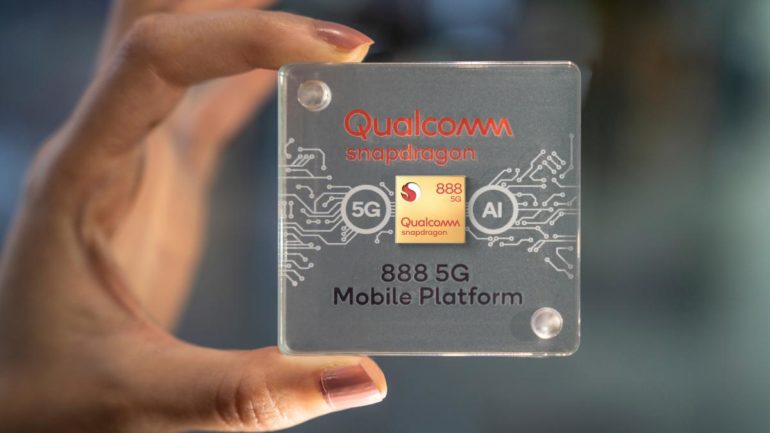Qualcomm announced on Tuesday the Snapdragon 888, its new high-end chip with a 5G modem for Android phones.
The new chip supports many types of 5G networks, improved graphics rendering and improved artificial intelligence capabilities for things like facial and image recognition.
The Qualcomm Snapdragon 888 will be at the heart of most high-end Android devices that launch in 2021. Qualcomm said phone makers including Xiaomi, Oppo, and Motorola are planning to use the Snapdragon 888.
Qualcomm is the dominant vendor of processors for Android devices, akin to Intel’s previous dominance as the best processor for Windows PCs. Qualcomm is in competition with handset makers like Apple, Samsung, and Huawei that develop their own smartphone chips, as well as Asian chipmakers like MediaTek.
Its high-end chips, like Snapdragon 888, or last year’s Snapdragon 865, take three years to develop on average. The features and performance are critical in persuading electronics makers to use Qualcomm silicon instead of cheaper options or building in-house.
Qualcomm’s most advanced chips are typically used in expensive phones that can cost $1,000. But, features and improvements from the 800-series end up in lower-cost chips designed for more affordable phones.
“The 800 sets the tone for the rest of the road map. And I would say, within three months, similar functionality goes to our 700 tier. Within another three months functionality goes to the 600 tier, and another three months, it goes to the 400 chip tier,” said Alex Katouzian, senior vice president for mobile at Qualcomm.
Qualcomm’s most advanced chips suggest what capabilities high-volume Android phones might have in the future. “A $250, $300 phone next year will probably perform better than a $600 or $700 phone two years ago,” Katouzian said.
Here are the big improvements to this year’s Snapdragon:
Integrated 5G
Qualcomm has integrated its third-generation 5G modem into the Snapdragon 888. Previously, smartphone makers had to use two different chips. This year, Qualcomm figured out how to improve manufacturing so that they could be integrated without hurting production, Katouzian said.
The integration uses less power and it’s easier to implement for phone makers. The 5G modem can also “aggregate” various carrier bandwidth bands to create a more reliable connection. One example is combining two different bands — TDD and FTD — that were pushed together by the merger of Sprint and T-Mobile. The X60 modem supports faster but less widespread millimeter wave networks and mainstream sub-6 5G flavors.
More powerful hardware for artificial intelligence
In recent years, silicon design has moved beyond clock speeds and core counts. Instead, chipmakers like Qualcomm are focusing on adding specific hardware for functions that a phone does all the time, like using artificial intelligence software to perform tasks such as image or facial recognition. The Snapdragon 888 has a new Hexagon 780 artificial intelligence processor integrated into the chip, which Qualcomm says performs 50% faster than last year.
Katouzian said the machine learning part of the chip manages 26 trillion operations per second, or TOPS, and can be used to automate advanced photography settings or recognize depth, faces and objects. Although it’s up to phone makers to design additional hardware and customize software to make it possible, Qualcomm says that its chip can support shooting video with HDR, which was a selling point of Apple’s recent iPhone 12.
Adreno GPU for improved gaming
The Qualcomm 888 has a built-in graphics processor (named the Adreno 660) that the company said renders graphics 35% faster. One smartphone maker using Qualcomm chips, OnePlus, said it can run Fortnite, a popular mobile shooter, at 90 frames per second, a common benchmark for gaming performance.
Qualcomm is betting heavily that high-end smartphone users will want to play more graphically advanced games on their mobile devices. Qualcomm is working with Tencent, one of the biggest games bankrollers, and is providing games-specifics drivers to smartphone makers, Katouzian said. Another new feature, Quick Touch, can reduce the lag from touchscreens while gaming.



